外研版(2019)选择性必修第三册Unit 5 Understanding ideas Nature in architecture 课件(25张ppt)
文档属性
| 名称 | 外研版(2019)选择性必修第三册Unit 5 Understanding ideas Nature in architecture 课件(25张ppt) | 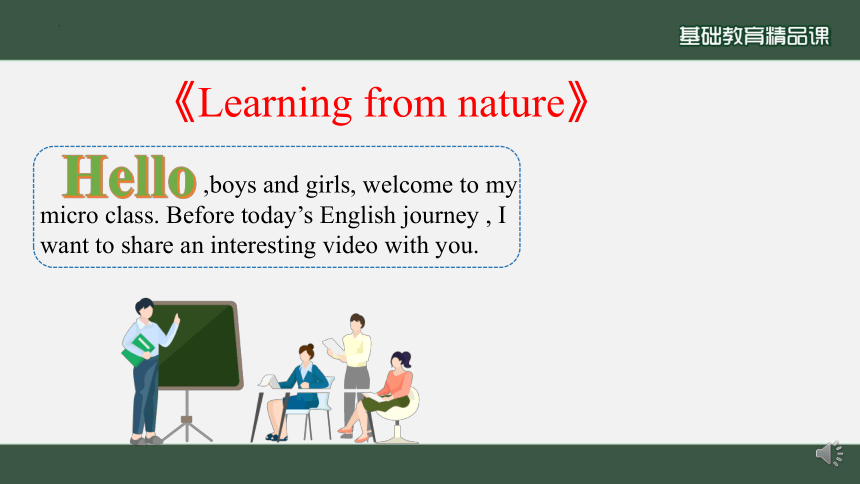 | |
| 格式 | zip | ||
| 文件大小 | 60.6MB | ||
| 资源类型 | 教案 | ||
| 版本资源 | 外研版(2019) | ||
| 科目 | 英语 | ||
| 更新时间 | 2022-10-11 08:14:20 | ||
图片预览




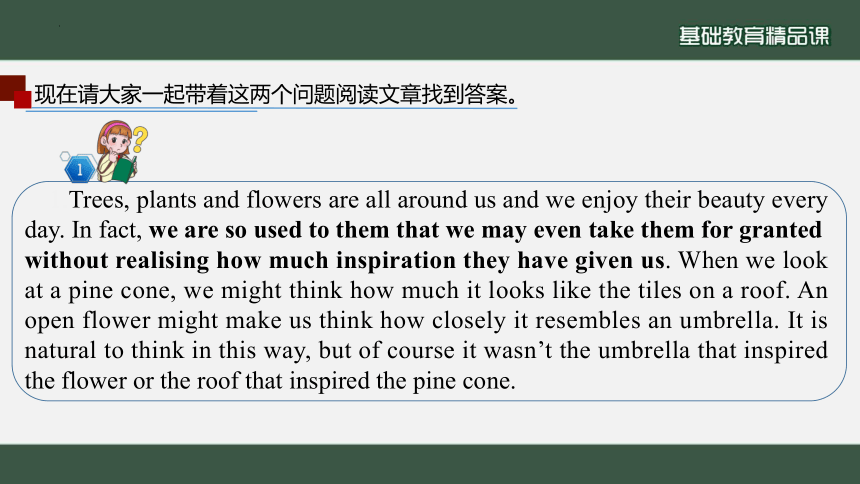

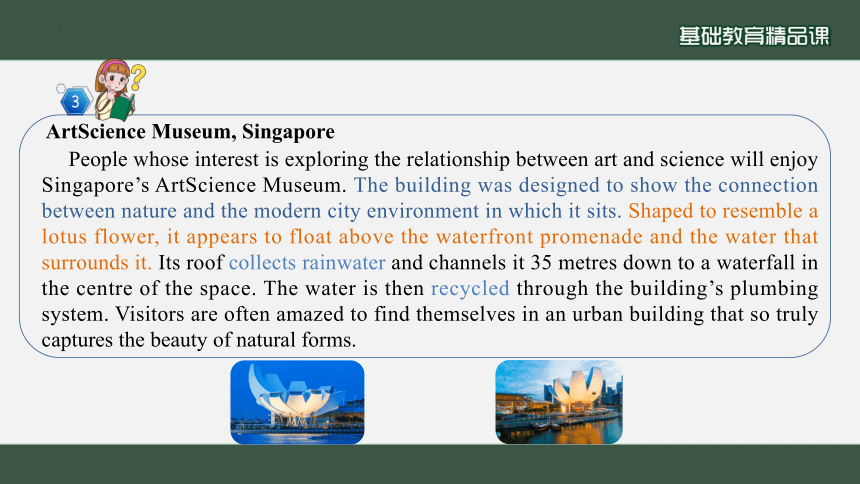
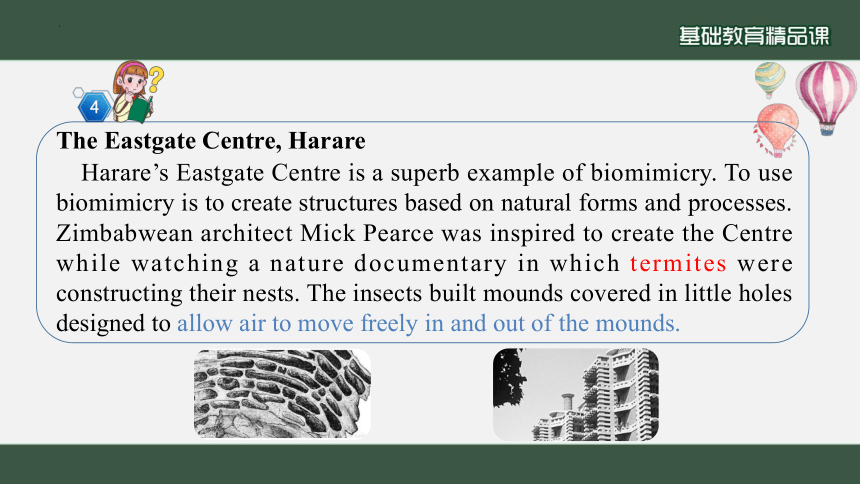
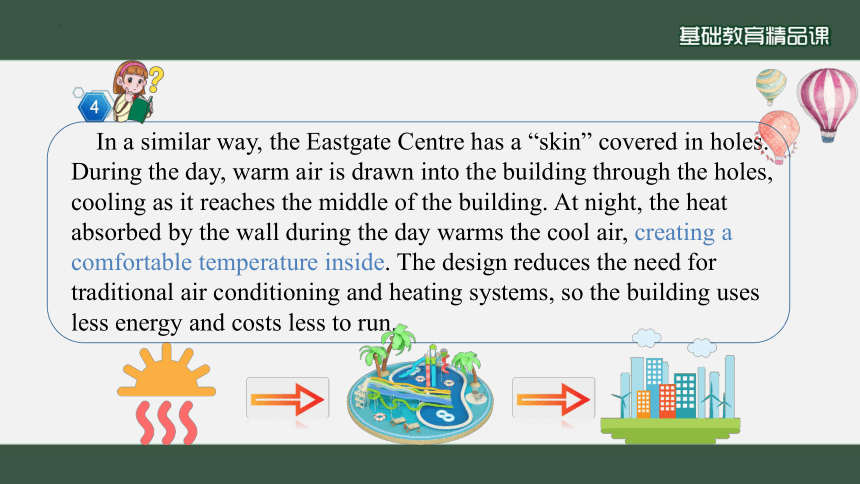
文档简介
(共24张PPT)
,boys and girls, welcome to my micro class. Before today’s English journey , I want to share an interesting video with you.
Hello
《Learning from nature》
After the video, we can see it is about our nature.
接下来,让我们一起来领略一下大自然的鬼斧神工给人
类建筑带来了哪些灵感。
There are two questions for you.
How could you associate them with architecture
Predict the whole passage according to a picture
and the tittle.
1.What is shown in the pictures
lotus flower, termite mound, algae
Part one、Pre-reading
1.Trees, plants and flowers are all around us and we enjoy their beauty every day. In fact, we are so used to them that we may even take them for granted without realising how much inspiration they have given us. When we look at a pine cone, we might think how much it looks like the tiles on a roof. An open flower might make us think how closely it resembles an umbrella. It is natural to think in this way, but of course it wasn’t the umbrella that inspired the flower or the roof that inspired the pine cone.
现在请大家一起带着这两个问题阅读文章找到答案。
Nature has inspired many of the most fascinating designs around us, including those in architecture. From Barcelona’s forest-like Sagrada Familia to the modern style of Beijing’s Water Cube, nature is presented in various architectural designs. Today, architects continue to explore ways to capture the beauty of natural forms, to mimic the way nature works or even to make natural organisms part of a building.
Sagrada Familia
Beijing’s Water Cube
People whose interest is exploring the relationship between art and science will enjoy Singapore’s ArtScience Museum. The building was designed to show the connection between nature and the modern city environment in which it sits. Shaped to resemble a lotus flower, it appears to float above the waterfront promenade and the water that surrounds it. Its roof collects rainwater and channels it 35 metres down to a waterfall in the centre of the space. The water is then recycled through the building’s plumbing system. Visitors are often amazed to find themselves in an urban building that so truly captures the beauty of natural forms.
ArtScience Museum, Singapore
Harare’s Eastgate Centre is a superb example of biomimicry. To use biomimicry is to create structures based on natural forms and processes. Zimbabwean architect Mick Pearce was inspired to create the Centre while watching a nature documentary in which termites were constructing their nests. The insects built mounds covered in little holes designed to allow air to move freely in and out of the mounds.
The Eastgate Centre, Harare
In a similar way, the Eastgate Centre has a “skin” covered in holes. During the day, warm air is drawn into the building through the holes, cooling as it reaches the middle of the building. At night, the heat absorbed by the wall during the day warms the cool air, creating a comfortable temperature inside. The design reduces the need for traditional air conditioning and heating systems, so the building uses less energy and costs less to run.
The world’s first algae-powered building is in Hamburg, Germany. The surface of the apartment building is covered in panels that contain algae. The algae are fed with liquid nutrients and carbon dioxide to encourage them to grow. In bright sunshine, they grow faster and provide shade. The panels also capture heat from the sun and convert it into energy that powers the building.
The Algae House, Hamburg
And that’s not all – the algae inside the panels can be harvested and used to produce fuel. The building therefore not only responds to its environment and uses less energy, but also reduces damage to the environment by generating its own renewable energy.
Creating buildings such as these enables us to live in closer harmony with our environment. To meet the needs of today while protecting the world of tomorrow may be a challenge, but even the simplest organisms can help teach us how to achieve this.
termite n.白蚁
algae n.藻类(植物)
capture v. 捕获
take……for granted 认为……理所当然
tile n.瓦片
architect n.建筑师
mimic v.模仿
waterfront n.滨水地区
promenade n.滨海步行道
plumbing n.管道系统
superb adj.极好的,出色的
biomimicry n.仿生学
convert v.使转变;使转换
(一)Fast reading
Part two、 While-reading
Magic nature
Nature in architecture
Magnificent buildings
Architects’ inspiration
1.Which tittle is the best Why
B选项最合适,因为B选项概括的最准确,本文讲的是三个不同的建筑吸取自然界事物的特点建造而成。既概括了大自然的鬼斧神工,又点明了建筑师从自然中获取的灵感。
1.What do we ignore when we ask for nature
we are so used to them that we may even take them for granted without realising how much inspiration they have given us.
(二)Careful reading
2.Which of the three buildings are you most impressed by Why
In my perspective, Singapore’s Art Science Museum impressed me most, because it’s unique shape of a lotus and its effect. It’s roof can collect rainwater. The water is then recycled through the building’s plumbing system. What’s about you
3.Organise information from the passage and complete the diagram.
There is much inspiration from nature in our daily lives, and nature has also inspired around us.
Introduction
architecture
To capture the beauty of natural forms
Shaped to resemble a the Art Science Museum seems to float above the waterfront promenade and . It collects rainwater through the roof and through its own plumbing system.
lotus flower
the water that surrounds it
recycle the water
Main body
To Based on the form and process of termite mounds, Harare’s Eastgate Centre also has little holes in the walls allowing air to , thus reducing the need for . In this way, it uses less energy and costs less to run.
create structures based on natural forms and processes
move freely in and out of the mounds
traditional air conditioning and heating systems
Main body
The Algae House is covered in panels containing algae. While the panels provide shade, and convert it into energy, the algae can also be used to . The building reduces damage to the environment by
capture heat from the sun
respond to its environment
.
generating its own renewable energy.
Main body
(一)Retell.根据文章,请根据例子,提炼关键词完成下列思维导图
Part three、Post-reading
(二)Discussion
If you were given a chance to design a building, what inspiration would you take from nature
(三)Writing
请欣赏下图,均是大自然给人类建筑带来的灵感的例子,请你任选一副,或自己创造一幅,描述它的作用以及意义。
一场自然与艺术的奇妙之旅现在就结束了,希望同学们不仅能掌握与本节阅读课相关的自然词汇表达,更能从自然中感受美好,得到启迪,善于发现自然界的美,尊重自然,爱惜自然。Bye-bye!
,boys and girls, welcome to my micro class. Before today’s English journey , I want to share an interesting video with you.
Hello
《Learning from nature》
After the video, we can see it is about our nature.
接下来,让我们一起来领略一下大自然的鬼斧神工给人
类建筑带来了哪些灵感。
There are two questions for you.
How could you associate them with architecture
Predict the whole passage according to a picture
and the tittle.
1.What is shown in the pictures
lotus flower, termite mound, algae
Part one、Pre-reading
1.Trees, plants and flowers are all around us and we enjoy their beauty every day. In fact, we are so used to them that we may even take them for granted without realising how much inspiration they have given us. When we look at a pine cone, we might think how much it looks like the tiles on a roof. An open flower might make us think how closely it resembles an umbrella. It is natural to think in this way, but of course it wasn’t the umbrella that inspired the flower or the roof that inspired the pine cone.
现在请大家一起带着这两个问题阅读文章找到答案。
Nature has inspired many of the most fascinating designs around us, including those in architecture. From Barcelona’s forest-like Sagrada Familia to the modern style of Beijing’s Water Cube, nature is presented in various architectural designs. Today, architects continue to explore ways to capture the beauty of natural forms, to mimic the way nature works or even to make natural organisms part of a building.
Sagrada Familia
Beijing’s Water Cube
People whose interest is exploring the relationship between art and science will enjoy Singapore’s ArtScience Museum. The building was designed to show the connection between nature and the modern city environment in which it sits. Shaped to resemble a lotus flower, it appears to float above the waterfront promenade and the water that surrounds it. Its roof collects rainwater and channels it 35 metres down to a waterfall in the centre of the space. The water is then recycled through the building’s plumbing system. Visitors are often amazed to find themselves in an urban building that so truly captures the beauty of natural forms.
ArtScience Museum, Singapore
Harare’s Eastgate Centre is a superb example of biomimicry. To use biomimicry is to create structures based on natural forms and processes. Zimbabwean architect Mick Pearce was inspired to create the Centre while watching a nature documentary in which termites were constructing their nests. The insects built mounds covered in little holes designed to allow air to move freely in and out of the mounds.
The Eastgate Centre, Harare
In a similar way, the Eastgate Centre has a “skin” covered in holes. During the day, warm air is drawn into the building through the holes, cooling as it reaches the middle of the building. At night, the heat absorbed by the wall during the day warms the cool air, creating a comfortable temperature inside. The design reduces the need for traditional air conditioning and heating systems, so the building uses less energy and costs less to run.
The world’s first algae-powered building is in Hamburg, Germany. The surface of the apartment building is covered in panels that contain algae. The algae are fed with liquid nutrients and carbon dioxide to encourage them to grow. In bright sunshine, they grow faster and provide shade. The panels also capture heat from the sun and convert it into energy that powers the building.
The Algae House, Hamburg
And that’s not all – the algae inside the panels can be harvested and used to produce fuel. The building therefore not only responds to its environment and uses less energy, but also reduces damage to the environment by generating its own renewable energy.
Creating buildings such as these enables us to live in closer harmony with our environment. To meet the needs of today while protecting the world of tomorrow may be a challenge, but even the simplest organisms can help teach us how to achieve this.
termite n.白蚁
algae n.藻类(植物)
capture v. 捕获
take……for granted 认为……理所当然
tile n.瓦片
architect n.建筑师
mimic v.模仿
waterfront n.滨水地区
promenade n.滨海步行道
plumbing n.管道系统
superb adj.极好的,出色的
biomimicry n.仿生学
convert v.使转变;使转换
(一)Fast reading
Part two、 While-reading
Magic nature
Nature in architecture
Magnificent buildings
Architects’ inspiration
1.Which tittle is the best Why
B选项最合适,因为B选项概括的最准确,本文讲的是三个不同的建筑吸取自然界事物的特点建造而成。既概括了大自然的鬼斧神工,又点明了建筑师从自然中获取的灵感。
1.What do we ignore when we ask for nature
we are so used to them that we may even take them for granted without realising how much inspiration they have given us.
(二)Careful reading
2.Which of the three buildings are you most impressed by Why
In my perspective, Singapore’s Art Science Museum impressed me most, because it’s unique shape of a lotus and its effect. It’s roof can collect rainwater. The water is then recycled through the building’s plumbing system. What’s about you
3.Organise information from the passage and complete the diagram.
There is much inspiration from nature in our daily lives, and nature has also inspired around us.
Introduction
architecture
To capture the beauty of natural forms
Shaped to resemble a the Art Science Museum seems to float above the waterfront promenade and . It collects rainwater through the roof and through its own plumbing system.
lotus flower
the water that surrounds it
recycle the water
Main body
To Based on the form and process of termite mounds, Harare’s Eastgate Centre also has little holes in the walls allowing air to , thus reducing the need for . In this way, it uses less energy and costs less to run.
create structures based on natural forms and processes
move freely in and out of the mounds
traditional air conditioning and heating systems
Main body
The Algae House is covered in panels containing algae. While the panels provide shade, and convert it into energy, the algae can also be used to . The building reduces damage to the environment by
capture heat from the sun
respond to its environment
.
generating its own renewable energy.
Main body
(一)Retell.根据文章,请根据例子,提炼关键词完成下列思维导图
Part three、Post-reading
(二)Discussion
If you were given a chance to design a building, what inspiration would you take from nature
(三)Writing
请欣赏下图,均是大自然给人类建筑带来的灵感的例子,请你任选一副,或自己创造一幅,描述它的作用以及意义。
一场自然与艺术的奇妙之旅现在就结束了,希望同学们不仅能掌握与本节阅读课相关的自然词汇表达,更能从自然中感受美好,得到启迪,善于发现自然界的美,尊重自然,爱惜自然。Bye-bye!
